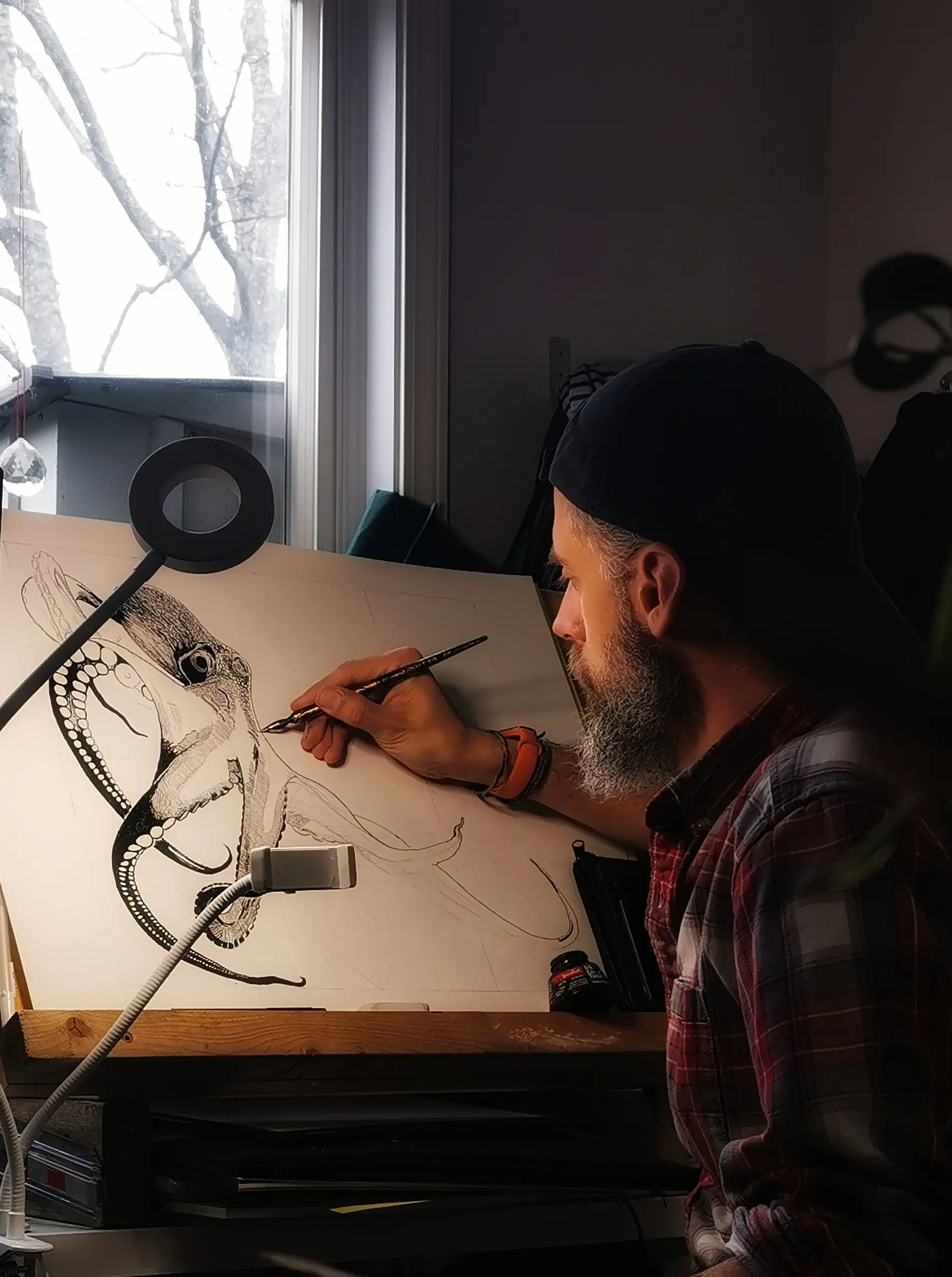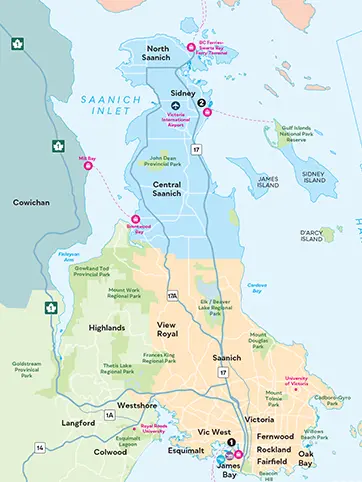
Wildlife Watching in Greater Victoria

Salmon run
Each autumn, various types of Pacific salmon make the impressive journey upstream British Columbia to spawn a new generation of salmon, then die. Visit Goldstream Provincial Park during late-October/early November to witness this natural phenomenon in Greater Victoria, as millions of Pacific salmon forge their way upstream.
This journey typically lasts for approximately nine weeks and attracts a frenzy of bald eagles, river otters, and racoons wishing to catch an easy snack. Black bears have also been known to show up to the party, albeit more infrequently.
Responsible Traveller Guidelines:
• Keep dogs on-leash away from the river, or consider leaving your pup at home at this time.
• Avoid wearing reds, purples, and pinks – the salmon are sensitive to these colours.
• Avoid moving quickly, and approach the riverbank quietly.
Image by @thorntontravels

Eagle extravaganza
The salmon run attracts local wildlife who feast in this nutrient-rich water. Most notably are the bald eagles, who come in such large numbers at the end of the salmon run that it’s often referred to as the “eagle extravaganza”! The Goldstream Estuary is closed at this time to allow the eagles to feast uninterrupted, while visitors can observe them from a safe distance.
If you’re visiting outside of the Salmon Run which occurs late October/early November, you can still bet your chances on seeing many eagles at Killarney Lake, which is near the larger Prospect Lake. Prepare yourself for a short hike in, and remember to peer between the trees into the lake – the eagles like to hang out on a fallen log in the centre of the lake. Consider packing your bathing suit – Killarney is a lovely watering hole for humans, too!
Top Goldstream Eagle Watching Tips:
• Start your visit at Goldstream’s Nature House, where Naturalists offer free interpretive programs about the Eagle Extravaganza, hot pastries, beverages and nature books.
• Bring your binoculars, as the Estuary is closed during the Salmon Run.
• Consider coming on a weekday during the Salmon Run, when the park is much less busy.

Bears
While encountering the odd black bear on a coastal trail isn’t entirely out of the realm of possibility (see our tips below to increase your bear aware-ness!), it is our responsibility to respect the bear and its home. As cuddly as a bear might look, it's important to remember that bears are large predatory carnivores who appreciate their space.
A favourite place for our local bears to hang-out is around local rivers and streams during the salmon run, at places such as Goldstream Provincial Park. If you're looking for a guided tour, many of the region's whale watching providers offer the opportunity for bear sightings as part of their wildlife viewing tours.
Tips on being Bear Aware:
• Do not feed or leave food for bears.
• Pack bear spray if heading out on our remote trails, and learn how to use it.
• Check the park’s webpage for any specific notices about bears in the area.
• While on the trail, make lots of noise, and hike in groups. The best way to protect both yourself and the bears is to avoid them. An adult black bear can run 50 kilometres per hour… you can not. We encourage you to visit BC Parks’ website for many more Bear Country safety tips.

Whale watching
A visit to Victoria is hardly complete without witnessing the impressive marine life that calls the Salish Sea, home. It is humbling to see these giants in their natural habitat, and we cannot recommend this transformative experience enough. Along with orcas, you may encounter gray, humpback or minke whales on your adventure.
Note: Whale watch tour operators in Greater Victoria adhere to a strict set of guidelines to “Be Whale Wise,” which are collaboratively set out by the scientists, researchers and governing bodies. Local whale watch companies charge a sustainability fee for each tour. This fee is donated directly to foundations that assist with the conservation and research of whales. Find a company and tour right for you here.
Be Whale-wise:
• In our part of Canada, boats must stay 400m away from orcas, dolphins, and porpoises.
• Drones can disrupt marine animals, therefore, they are discouraged to fly over our ocean unless appropriate permits are obtained.
• Refrain from fishing within 1000m of whales.

Coastal-life viewing
While out exploring the Pacific Ocean on a whale watching tour, it’s likely you’ll also encounter seals, otters, sea lions and maybe even a coastal wolf. However, you don’t have to be on the water to spot marine life. Stumbling upon a seal malting on a beach, sea lions sunbathing on coastal rocks or viewing whales from the shoreline is always a possibility on the coast.
Responsible Traveller Tips:
• Never feed any wildlife you encounter. Under the Park, Conservancy and Recreation Area Regulation and the Wildlife Amendment Act, it is an offence to feed wildlife.
• If camping, keep your lot clean and orderly, and pack and suspend your food, toiletries, and garbage from an out-of-reach tree.
• Keep pets leashed and under control, or consider leaving them at home.
Photo credit: Prince of Whales Whale & Marine Wildlife Adventures

Under the sea
Want to get a close look at underwater marine life? Venture out to the Shaw Centre for the Salish Sea, southern Vancouver Island’s aquarium. From 28 different underwater habitats, view anemone, local fish species, wolf eels, and even a giant pacific octopus. This aquarium and cultural centre dedicated exclusively to the learning, exploration and conservation of the Salish Sea Bioregion.
Another great spot for seeing a unique abundance of marine life lies two hours from Victoria… but it’s well worth the drive. Seek out Botanical Beach Provincial Park, home to several rare tide pool formations that house chitons, seastars, anemones, urchins, and if you’re lucky: octopus. Gaze out into the ocean, and you may see harbour seals, gray whales, or orca!
Photo credit: John Rawlings

Birds!
Bird-watchers will find Vancouver Island home to a variety of species that inhabit our local forests, bays and seashores. From peacocks roaming Beacon Hill Park and herons along the water’s edge, to eagles and Cooper’s hawks soaring overhead, there’s no doubt Vancouver Island is home to incredible birding. Or, join a local birder for a morning walk around Swan Lake Nature Sanctuary.
Esquimalt Lagoon‘s bird sanctuary may be one of the island’s best bird-watching spots, and is a frequent stop for migratory birds along the Pacific Flyway. Point Ellice House’s shoreline is also located along the Victoria Migratory Bird Sanctuary attracting plenty of waterfowl. It makes for a lovely visit if you want to ‘view’ two Victorian birds with one stone: wildlife viewing and heritage site visitation. Have lunch at the nearby Glo Restaurant + Lounge – equipped with a gorgeous waterfront patio, this restaurant is perfect for bird watchers.
Birds of prey, including raptors, hawks, owls, falcons and more can be studied up close at The Raptors in Cowichan.
The Malahat Skywalk is also a wonderful place for bird-watching, where you can get an eagle’s eye view of hawks, raptors, ravens, crows and vultures from above.

Rainforest bound
Embark on an adventure into Vancouver Island's mighty coastal rainforests. Within these towering cedars there's a myriad of wildlife to behold, big and small. From millipedes and tree frogs to elk, wolves, and even cougars (oh my!). This serene wilderness is home to some of the largest trees in the world, and within these forest a patchwork of trails exploring the brilliant biodiversity of the island. Some great places to explore our forests (or the bush as the locals might call it) are Goldstream Provincial Park, Mount Wells, and the Juan de Fuca Marine Trail.
Responsible Traveller Tips:
• Pack in, pack out. You are responsible for your own waste.
• Take only pictures, leave only footprints.
• Be prepared. Trails in wilderness areas travel through dense forest, uneven terrain, and unpredictable weather patterns. Ensure you have proper footwear, clothing, water, first-aid, and emergency supplies.
• Always let someone outside of your group know where you will be hiking.
Explore more of our wild side
Check out Netflix’s “Island of the Sea Wolves” and embark on a journey across the island, deep into our rainforests, meeting the furry and feathered locals who call our rock in the Pacific, home.




